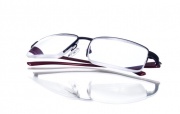Contents |
Chase Away the Blues
High-Energy Visible Light
Sometimes we might feel like smashing our computers and smart phones to bits, but we are using such things more and more all the time, and most of us have adapted. They allow us to communicate and learn at rates undreamed of only a few years ago, and most of us would find it almost impossible to imagine life without our electronic gear, our computers, smart phones, tablets and digital readers. Recent studies have shown that most of us wouldn’t be comfortable without them for more than a day or so at most. Our children have always had them as part of their lives.
Technology is mostly a good thing, of course, but we owe it to ourselves to use it in the best possible ways.
Eyecare practitioners are beginning to have some concerns about our extended use of electronics, and especially the type of blue light radiating from them. This is just what it sounds like, light that appears blue, and it may be important to our overall well-being as well as the health of our eyes; High-Energy Visible Light (HEV or HEVL) is from the edge of the visible light spectrum, just above the area of Ultraviolet (UV) light.
We have known for a while now that ultraviolet radiation, the high-energy radiation that comes from the sun, can cause health problems, including premature skin aging and certain skin cancers. Many of us also know that ultraviolet can cause long term damage to our eyes as well, like macular degeneration and cataract formation. It stands to reason that if UV light is harmful, light right next to it in the blue area of the visible spectrum could also cause some problems.
HEVL packs a punch, because it is very energetic and can penetrate easily all the way to the back of the eye. This type of light is present not only in digital electronic devices, but in fluorescent lights, compact fluorescent bulbs, and LEDs, especially ultra-blue or cool blue versions. Increasingly, LEDs are being used to replace incandescent and fluorescent lighting because it saves so much energy, but they may also lead to the unintended result of eye damage from HEV light.
In general, eye doctors have two concerns when it comes to extended use of electronics, that of computer-related eyestrain and the effects of HEV light radiating from them.
Computer Eyestrain
The first, eyestrain, is quite common and most people have experienced it without even knowing what it was; if you have ever felt your eyes get tired, dry or runny after a few hours at the computer, chances are that eyestrain was the culprit. As simple as it sounds, one of the best ways to relieve such eye stress is to blink more, because when we are concentrating on a screen, the normal rate of blinking drops significantly. Temporary eyestrain can become a chronic problem if ignored.
A good guideline to follow for better comfort at the computer is the 20/20/20 rule: every 20 minutes, look up at something at least 20 feet away and stare at it for at least 20 seconds. This allows the focusing system to reset itself and relax, while restoring a normal blink rate. Conscious blinking is also helpful, although it is difficult to remember to do it while concentrating on something else.
HEV Light
But the more problematic of the two concerns noted is that of HEVL. This high-energy light can not only affect our eye health, it can alter how we feel and how we sleep. Unlike eyestrain, the damage from blue light rays is cumulative and can be permanent.
Children are at special risk for damage from blue light for two reasons; they will use these devices during their lifetimes much more than adults ever will, and their eyes are still developing and don’t have all the protective pigments in their eyes yet that help filter these rays out. Like ultraviolet radiation, most exposure to HEV light will happen before the age of 18.
Of course, adults are at risk also, especially because of the increasing usage of digital devices, in both their working and private lives. Also, it is important to understand that not all blue light is bad; lower-energy turquoise-to-green light allows our bodies to regulate production of melatonin, an important hormone related to sleep cycles.
Eye Protection
First, if you are not able to limit your use of your digital devices, at least cut back on them just before bedtime. Some blue light helps us, because it allows us to be energetic and alert by keeping our melatonin levels lower during daylight; at night, we need melatonin because it encourages REM-stage, or dreaming, deep sleep, so try to avoid using blue-radiating devices for at least two hours before bed.
Second, ask your eyecare practitioner about spectacle lenses available which can filter out not only harmful ultraviolet light but the harmful HEV light as well. Unlike the old, bright yellow “blue-blocker” type lenses from the eighties and nineties, these new lenses have almost no tint at all, and can be a big factor in minimizing exposure to high-energy blue light, while allowing the more beneficial parts of the spectrum to pass. In addition, most people who try them experience an increase in eye comfort right away, because they improve contrast, which is relaxing for the eyes.
We do not need to toss our computers and smart phones out the window, nor forgo the energy saving capabilities of LED bulbs, but we do need to be aware of the risks and the means of protecting ourselves from HEV light coming from them.


